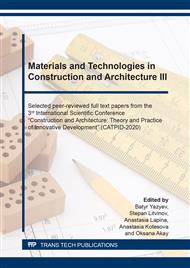[1]
S. Lim, R.A. Buswell, T.T. Le, S.A. Austin, A.G.F. Gibb, T. Thorp, Developments in construction-scale additive manufacturing processes, Automation in Construction. 21 (2012) 262–268.
DOI: 10.1016/j.autcon.2011.06.010
Google Scholar
[2]
B. Berman, 3-D printing: the new industrial revolution, Business Horizons. 55-2 (2012) 155˗162.
DOI: 10.1016/j.bushor.2011.11.003
Google Scholar
[3]
J.W. Stansbury, M.J. Idacavage, 3D printing with polymers: challenges among expanding options and opportunities, Dental Materials. 32 (1) (2016) 54–64.
DOI: 10.1016/j.dental.2015.09.018
Google Scholar
[4]
P. Gerbert, S. Castagnino, S. Rothballer, A. Renz, R. Filitz, Digital in engineering and construction, The Boston Consulting Group, USA, Information on futureofconstruction.org/content/uploads/2016/09/BCG-Digital-in-Engineering-and-Construction-Mar-2016.pdf, (2016).
Google Scholar
[5]
World Economic Forum, Shaping the future of construction - future scenarios and implications for the industry, World Economic Forum, Geneva, Switzerland, http://www3.weforum.org/docs/Future_Scenarios_Implications_Industry_report_2018.pdf, (2018), Accessed date: 8 August (2018).
Google Scholar
[6]
Wu P., Wang J., Wang X., A critical review of the use of 3-D printing in the construction industry, Automation in Construction. 68 (2016) 21-31.
DOI: 10.1016/j.autcon.2016.04.005
Google Scholar
[7]
F. Craveiro, J.P. Duarte, H. Bartolo, P.J. Bartolo, Additive manufacturing as an enabling technology for digital construction: A perspective on Construction 4.0, Automation in Construction. 103 (2019) 251-267.
DOI: 10.1016/j.autcon.2019.03.011
Google Scholar
[8]
A.G. Frank, L.S. Dalenogare, N.F. Ayala, Industry 4.0 technologies: Implementation patterns in manufacturing companies, International Journal of Production Economics. 210 (2019) 15-26.
DOI: 10.1016/j.ijpe.2019.01.004
Google Scholar
[9]
H. Kagermann, W. Wahlster, J. Helbig, Recommendations for Implementing the Strategic Initiative Industrie 4.0: Securing the Future of German Manufacturing Industry, Final Report of the Industrie 4.0 Working Group. Acatech, Forschungsunion, (2013).
Google Scholar
[10]
García de Soto B., Agustí-Juan I., Hunhevicz J., Joss S., Graser K., Habert G., B.T. Adey, Productivity of digital fabrication in construction: cost and time analysis of a robotically built wall, Automation in Construction. 92 (2018) 297–311.
DOI: 10.1016/j.autcon.2018.04.004
Google Scholar
[11]
A. Chergui, Hadj-Hamou K., F. Vignat, Production scheduling and nesting in additive manufacturing, Computers & Industrial Engineering. 126 (2018) 292–301.
DOI: 10.1016/j.cie.2018.09.048
Google Scholar
[12]
D.R. Eyers, A.T. Potter, Industrial Additive Manufacturing: A manufacturing systems perspective, Computers in Industry. 92-93 (2017) 208-218.
DOI: 10.1016/j.compind.2017.08.002
Google Scholar
[13]
M.K. Niaki, Ali Torabi S., F. Nonino, Why manufacturers adopt additive manufacturing technologies: The role of sustainability, Journal of Cleaner Production. 222 (2019) 381-392.
DOI: 10.1016/j.jclepro.2019.03.019
Google Scholar
[14]
S.H. Ghaffar, Corker J., M. Fan, Additive manufacturing technology and its implementation in construction as an eco-innovative solution, Automation in Construction. 93 (2018) 1-11.
DOI: 10.1016/j.autcon.2018.05.005
Google Scholar
[15]
J. Pegna, Exploratory investigation of solid freeform construction, Automation in Construction. 5 (1997) 427–437.
DOI: 10.1016/s0926-5805(96)00166-5
Google Scholar
[16]
T. Anjum, P. Dongre, F. Misbah, N. Nanyam, Purview of 3DP in the Indian Built Environment Sector, Procedia Engineering. 196 (2017) 228–235.
DOI: 10.1016/j.proeng.2017.07.194
Google Scholar
[17]
C. Gosselin, R. Duballet, Ph. Roux, N. Gaudillière, J. Dirrenberger, Ph. Morel, Large-scale 3D printing of ultra-high-performance concrete – a new processing route for architects and builders, Materials and Design. 100 (2016) 102–109.
DOI: 10.1016/j.matdes.2016.03.097
Google Scholar
[18]
B. Khoshnevis, Automated construction by contour crafting-related robotics and information technologies, Automation in Construction. 13 (2004) 5–19.
DOI: 10.1016/j.autcon.2003.08.012
Google Scholar
[19]
Buswell R., Soar R., Gibb A., Thorpe A., Free form construction: mega-scale rapid manufacturing for construction, Automation in Construction. 16 (2007) 224–231.
DOI: 10.1016/j.autcon.2006.05.002
Google Scholar
[20]
Cesaretti G., Dini E., Kestelier X.D., Colla V., Pambaguian L., Building components for an out-post on the lunar soil by means of a novel 3d printing technology, Acta Astronautica. 93 (2014) 430–450.
DOI: 10.1016/j.actaastro.2013.07.034
Google Scholar
[21]
Lu K., Reynolds W.T., 3DP process for fine mesh structure printing, PowderTechnology. 187 (2008) 11˗18.
DOI: 10.1016/j.powtec.2007.12.017
Google Scholar
[22]
Utela B., Storti D., Anderson R., Ganter M., A review of process development steps for new material systems in three-dimensional printing (3DP), Journal of Manufacturing Processes. 10 (2008) 96–104.
DOI: 10.1016/j.jmapro.2009.03.002
Google Scholar
[23]
N. Lyubomirskiy, A. Bakhtin, S. Fic, M. Szafraniec, T. Bakhtinа, Intensive Ways of Producing Carbonate Curing Building Materials Based on Lime Secondary Raw Materials, Materials. 13 (2020) 2304.
DOI: 10.3390/ma13102304
Google Scholar


